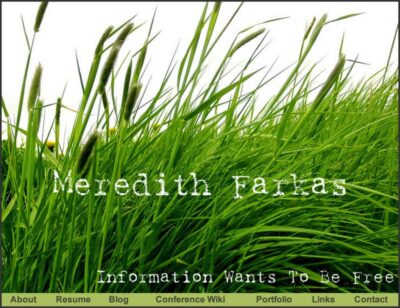On Saturday, I went to two sessions that were really a study in contrasts. After the first one, I felt like I’d heard it all before. After the second one, I was overwhelmed with a wealth of new information. The first one left me feeling cold. The second one left me feeling energized and optimistic. The first one made me feel like the bulk of the profession was never going to see things differently. The second helped me to see that lots of people in the profession are doing amazing things with technology and are constantly reevaluating their approach based on the needs of our patrons.
E-Reference Services: What Are Our Users Telling Us?
Here was the program’s description:
How much do we know about information-seeking behaviors in the digital age and how much e-reference services mesh with users’ expectations? Instant Messaging is used by 90% of teens and 48% of adults online, states a recent survey; yet many e-reference services report low usage. What role does-and-will-the library play for them? Just what can we learn from our users that will help us plan and design 21st-Century electronic reference services? Presentations by Charles McClure and Sara Weissman, plus a joint presentation by Sharon Morris, Louise Greene, and Laura Kortz.
Being a big advocate of IM reference, I was curious to hear the speakers’ conclusions regarding how vendor-created virtual reference software has thus far met the needs of library patrons. Unfortunately, sofware was never mentioned in this program. In fact, the program hardly resembled the description at all.
The first speaker, Sara Weissman, described the non-intrusive analyses she had done of her patron population and their usage of the Morris County Library’s virtual refernence service. Weissman did her analyses because the usage stats at her library were so low. She didn’t mention what software she used for virtual reference and did not mention IM at all. However, she did suggest that it is important for libraries to reduce costs and reduce technology barriers. The most important question Weissman asked, in my opinion, was “what do you count as a reference interaction?” If one library considers “where is the bathroom” a reference question and another library has a narrower definition, how can we compare statistics?
I was excited to hear what Charles McClure, of my alma mater, had to say about virtual reference as I know he is big on critically evaluating things most librarians take for granted. While he was critical, he didn’t really discuss “what out users are telling us”. He instead talked about how many of the methods we use to assess effectiveness of library services are not very useful. Specially, he discussed the results he got from exit interviews when he did an evaluation of NCknows — a statewide collaborative reference service — where he found that users are often happy if they got the information they needed, even if the service was terrible. He also talked about how the grant funding that has facilitated the creation of many state virtual reference services will not last forever, and that libraries need to come up with sustainability plans. While he made some good points, I don’t think he really talked about what users are telling us or how we can improve virtual reference services.
The final speaker, Sharon Morris, discussed her evaluation of Colorado’s statewide virtual reference service. She shared a number of statistics, including the fact that 6th – 8th graders made up the largest group of virtual refernece users. She also looked at how most teens do research on the Internet, which seemed like an accurate portrayal and should be taken into account when providing reference services. Something I didn’t like is that she shared many of the silly comments some teens made about the service, which didn’t seem to serve any purpose but to get a laugh. Morris agreed with Charles McClure that exit interviews were pretty useless in determining the efficacy of a library service. She was the only one of the three who really discussed user behavior and user needs. She mentioned how many users prefer IM, which was the only time it was mentioned during the entire talk.
All in all, I found the talk disappointing. There was no discussion about how the software used to provide virtual reference services might affect the efficacy of the service, and there was very little discussion of user needs.
LITA Top Technology Trends – An Ongoing Discussion with Library Technology Experts
Yes, yes, YES!!!! What a breath of fresh air (especially after that last session)! I came out of the Tech Trends segment feeling so electrified and hopeful about the profession.
This session has been covered in the LITA Blog by Genny and Lisle. In addition, a number of the participants in the session posted some of their trends to the LITA Blog. Here is the list of participants with links to their postings on the blog:
- Sarah Houghton (virtually)
- Tom Wilson
- Andrew Pace
- Roy Tennant
- Karen Schneider
- Eric Lease Morgan
- Marshall Breeding
- Milton Wolf
- Joan Frye Williams
- Cliff Lynch
I’m not going to go through the entire session in detail since I took eight pages of notes and plenty of people have covered it admirable. I will mention some things that really interested me:
- Sarah asserted that virtual reference services should be more lightweight, like IM and Jybe. Karen agreed and wondered what virtual reference would look like if we’d just started with IM instead of getting wrapped up in these big, clunky vendor “solutions”.
- Tom wilson discussed the problem of digital archiving/preservation. Right now, we don’t really know which preservation approach is statistically the safest, but with so much data on the web (much of which was born digital) that libraries have to choose some approach. Eric Lease Morgan also raised concerns about the preservation of works that are born digital. I wonder whether Google and the libraries involved with them have a plan for preserving all of the digital surrogates they’re creating, because it can end up being more expensive than the original digitization work.
- Can I tell you how much I love anyone who says that library middleware sucks?!?!? (kisses to Andrew Pace and Roy Tennant!) Anyone who has read my blog knows how strongly I feel that the electronic middleware is often to blame for users not finding what they’re looking for. To hear these ideas coming from the mouths of people whom I respect fills me with hope for the future of our library systems.
- Note to self: learn more about web services. Eric thinks that users are going to come to our website less and less and are going to access our content from other venues (library lookup anyone?). Roy, Eric, and Marshall talked about how XML and Javascript are making it possible to layer diverse websites over one another to create an entirely new service (a great example is Chicago Crime.org).
- Roy warned librarians not to lose sight of our mission in the face of corporate interest (ie. Google). He thinks that Google Print might harm other library digitization efforts and that Google Print is creating serious copyright issues that might jeoparadize fair use for libraries. Regardless of whether Google is good or bad, it is obvious that their projects are going to impact libraries, and that some of the impact may not be positive. Marshall Breeding also talked about the impact of vendors on libraries. He said that a lot of decisons that affect libraries are being made outside of libraries (in corporate America). We need to advocate for ourselves and our patrons, because library vendors are out to make a profit first.
- Libraries need to invest more in technology training. Milton Wolf stated that the largest growing portion of the population were those over 85. With the aging of the population, we see a lot of people retiring who still want to be involved, and more older Americans spend their time at the library than the senior center. Many of these people are learning about technology for the first time and libraries need to beef up their technology training to meet their needs. Sarah also thinks that libraries need to increase their investment in technology training. She thinks libraries should start training users in “non library” topics, such as blogging, e-commerce, etc. We should be more about meeting users’ needs and less stuck on what libraries “should” be teaching.
- Other issues brought up: Digital Rights Management, disruptive technology, metasearch, information discovery, wireless access becoming ubiquitous, mass storage devices holding an entire operating system, open access publishing, personalization without getting personal, libraries taking advantage of collaborative technologies, and data curation.
Obviously, a lot of food for thought, but very exciting stuff! I think there’s hope yet for our libraries! 🙂
I’ll blog about the OCLC Bloggers soiree in another post…




Thank you for the kind words, Meredith (and kisses, even 😉 ), but I find it interesting that you think hearing such things from us old farts means there is hope for the profession. I actually think the real hope for the profession doesn’t lie with us who have maybe 10-15 years to make a contribution, but rather with you and other new librarians who “get it” and have the right chops to do something about it.
Part of the reason why I think OCLC hit a home run with the Blogger’s get together was that it was the Old School giving the New School their due. I’m sure it didn’t escape you that folks like Jay Jordan, Walt, and I were greatly outnumbered by those new to the profession (some still in school!). The more we old folks can give you young ones a leg up on making an impact, by connecting you to each other and greasing the wheels, the farther you can take us. Rock on!
I guess I don’t think of it as old vs. young, but people with influence (ie. people who talk at lots of conferences and get published a good deal) versus people who don’t have so much influence yet (ie. me). Most librarians I talk to who are in positions of authority/influence sadly do not think the way you do. The more people you can convince that library middleware is a problem — and fight against the “users are stupid” mode of thinking — the better off our libraries will be. In that way, too, you’re greasing the wheels for us young’uns to make a difference.